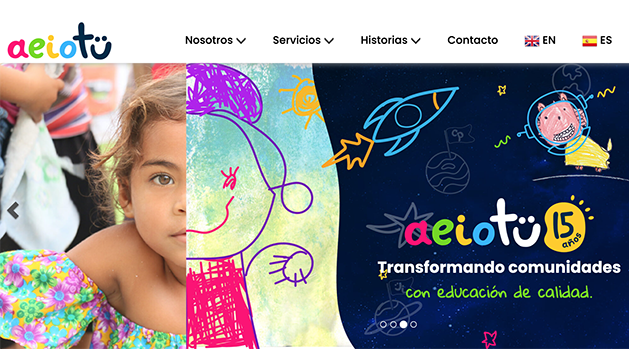
Diseñada por Freepik
In recent years, the presence of technology in daily life has become undeniably important. Tablets, smartphones, and personal computers have become commonplace tools at home, in schools, and in public spaces. Even the youngest children are no exception. We see it daily: babies in restaurants or on public transport interacting with digital devices. According to Toddlers, Tech and Talk (2024),
This context raises questions about how new generations interact with technology from their earliest years, how it influences their cognitive and linguistic development, and what kinds of consequences or benefits may be observed in the medium and long term.
The study, which tracked the digital habits of families from diverse backgrounds over two years, analyzes the dimensions of technology use in areas such as play, education, and family dynamics. According to the data, many parents express interest in the educational and cultural potential of applications. In fact, the vast majority believe these tools offer great opportunities for learning numbers (83%), reading (75%), and creative skills (75%). However, they also express concerns about issues related to online safety and the potential overuse of screen time.
Beyond these concerns, a combination of cultural, socioeconomic, and educational factors seems to determine how each family integrates technology into their daily routine. For this reason, the document examines both the benefits and the challenges and inequalities that arise in access to devices.
Below, we analyze its main conclusions and offer some proposals focused on a more conscious and constructive use of digital resources.
developed by the University of Manchester, 41% of children aged 0 to 3 have access to a tablet, and 12% regularly use a smartphone for various activities.
The vast majority believe these tools offer great opportunities for learning numbers (83%), reading (75%), and creative skills (75%). However, they also express concerns about issues related to online safety and the potential overuse of screen time.
The Advantages of Technology in Child Development
Multimodal Learning and Early Stimulation, Always with Guidance
One of the most notable advantages highlighted in the Toddlers, Tech and Talk report is the opportunity for multimodal learning. From interactive apps to videos with educational content, devices have enabled many children to experience simultaneous visual, auditory, and tactile stimuli. Platforms like CBeebies, Reading Eggs, and Duolingo ABC, designed to encourage language development, digital literacy, and fine motor skills, aim to capture young children’s attention through playful, family-engaging elements.
For parents and educators considering leveraging these resources, evidence suggests that the presence of an adult enhances learning outcomes. Watching an educational program together or using a reading app while discussing new words significantly increases positive results. This is where the most significant changes in child development are observed, as human interaction serves to organize and contextualize information. It’s not all about the app or the video—the role of the adult remains crucial in guiding the experience and addressing questions.
Family Connections and Cultural Bonds
In many households, video calls have become an effective bridge to maintain contact with family and friends living far away. The report indicates that 60% of families frequently use video calls to connect with grandparents, aunts, uncles, or other loved ones who cannot be physically present. This practice holds special value in contexts where families are spread across different countries or communities, facilitating the use of multiple languages within the same digital environment.
The ability to connect young children with relatives who speak another language creates opportunities for “translanguaging,” or the flexible switching between languages depending on the situation. Frequent contact through video calls not only helps maintain emotional closeness but also reinforces linguistic immersion in varied contexts. Research shows that children who interact with relatives in another language acquire or retain richer communicative skills, a significant component of their cultural identity.
For migrant families, technology has often become a cornerstone for providing cultural references to their children. Parents can share videos of celebrations or traditions from their home country, recount family stories, or even organize virtual gatherings to celebrate important events. This resource becomes invaluable when geographic distance complicates frequent visits, offering a means to keep certain customs alive despite physical separation.
Digital Play and Creativity
According to a survey of 1,444 parents conducted as part of the study, 58% use apps and devices to encourage creative activities with their children. Digital drawing tools, musical games, and simulations of everyday scenarios (such as virtual shops or interactive kitchens) are part of the daily lives of many children. While some people have expressed concerns about electronic toys, proponents of these environments highlight that they foster exploration, provided they are combined with physical and social interaction.
The British report emphasizes that for families with children with disabilities, technology becomes an especially valuable resource. Mentioned are augmentative and alternative communication apps, as well as programs with sensory stimuli designed for children needing specific support. The study finds that parents of children with special needs use devices nearly twice as often as other families for educational purposes. This difference is attributed to the convenience of customizable programs that allow each child to progress at their own pace and strengthen the areas where they need the most support.
Risks and Concerns of Early Exposure
Despite the variety of benefits, a recurring concern is the excessive amount of screen time. Among surveyed families, 67% express worry about potential issues such as a lack of physical activity, reduced sleep, and the impact on visual health.
The World Health Organization (WHO) has published guidelines recommending that children under five be limited to a maximum of one hour of screen time per day, always under adult supervision. The debate about the validity of these recommendations often focuses on the quality of the content being viewed and how it is integrated into the child’s daily routine.
Another significant issue raised is uncontrolled internet access. About 62% of parents fear their children might encounter age-inappropriate material online. Although platforms like YouTube Kids attempt to apply safety filters, flaws in these systems can allow unsuitable videos or ads to circulate. Parental controls and password settings on devices have become common practices, but they are not always reliable or consistently effective.
The potential for technology dependence is another frequently discussed topic. The report describes instances where children begin to demand tablets or smartphones as their primary source of entertainment, which can limit the development of social and emotional skills that are enriched through direct interaction with other children and adults. Approximately 70% of parents agree that devices are beneficial as long as they do not replace other childhood experiences.
Academic evidence comparing families with varying digital routines suggests that those incorporating traditional play, reading, and regular interaction with other children achieve a better balance in screen use. These families report fewer challenges related to screen time dependency and greater overall well-being among children.
Around 70% of the surveyed parents agree that devices are beneficial, as long as they do not replace other childhood experiences.
The Digital Divide and Inequalities in Access
The report also examines a critical issue: not all families have the same access to technological resources. Socioeconomic factors play a decisive role. Families with lower incomes tend to have fewer devices and lower-quality internet connections, limiting access to educational platforms and other early learning tools. While some households own more than 40 digital devices (including smartphones, tablets, smart TVs, and computers), the overall average is 12.5, and lower-income families often fall below half that figure.
Parental education emerges as another factor influencing technology use. The data show that parents with higher education levels feel more confident using educational apps with their children. In contrast, parents without specific information or training often hesitate, fearing they might make mistakes or fail to guide their children effectively. In multicultural family contexts, a linguistic divide is also evident: not all content is available in the everyday languages spoken at home, complicating the transmission of the mother tongue and the preservation of cultural identity.
The Toddlers, Tech and Talk study aligns with reports from UNESCO and organizations like the ProFuturo Foundation, which emphasize the importance of ensuring equal access to technology from an early age to promote educational inclusion. These organizations highlight the urgent need for public policies aimed at providing stable internet connections in underserved communities and promoting digital skills training for both parents and teachers. The goal is to narrow the gap between those who can benefit from quality digital resources and those excluded due to economic or geographic barriers
Recommendations for More Constructive Use
The University of Manchester report provides several proposals aimed at integrating technology responsibly into early childhood environments. One of the most significant recommendations is to establish a balanced approach to technology use. The idea is not to completely ban devices but to combine digital activities with physical play, traditional reading, and social interactions. Parents can set specific schedules for using tablets or computers, ensuring they do not become a constant distraction.
The report emphasizes the importance of focusing on high-quality content. Experts involved in the study advise families to select apps and programs specifically designed for early childhood development. Choosing platforms with clear educational goals can foster cognitive, linguistic, and motor skills. Additionally, it is recommended that adults be present while children interact with digital content. Engaging in conversations about what is being viewed on-screen reinforces understanding and prevents misunderstandings.
Active parental participation might include watching educational programs together, trying interactive apps that introduce basic math or vocabulary, and asking questions related to the characters or storylines. These shared activities strengthen family bonds and support collaborative learning. The report notes that children whose parents stay engaged during screen sessions demonstrate greater focus and better retention of key concepts.
On a broader level, the report advocates for public policies that enhance access to devices and digital literacy training in under-resourced communities. Proposed measures include:
Providing preconfigured tablets in community centers or libraries.
Training educators to identify and recommend age-appropriate content.
These initiatives aim to ensure that the benefits of technology extend to families who might otherwise be excluded due to economic limitations. By making technology more accessible and promoting informed usage, these recommendations seek to bridge the digital divide and maximize the positive impact of digital tools in early childhood development.
Reflections on Responsible Use
The Toddlers, Tech and Talk (2024) report highlights that technology is an integral part of early childhood in a significant number of households. As discussed throughout this analysis, digital tools offer numerous opportunities to enhance cognitive skills, maintain cultural connections, and foster creativity. However, the risks associated with screen exposure and lack of supervision should not be underestimated. A substantial percentage of parents express concerns about online safety, inappropriate content, and excessive dependency on devices.
Parenting and education in the digital age face challenges that demand the involvement of parents, educators, policymakers, and the tech industry itself. Although socioeconomic and cultural barriers persist, the commitment to creating safer and more appropriate digital environments can make a substantial difference. Following the recommendations outlined in this report and continuing research that addresses the role of family, cultural diversity, and market trends will be essential to shaping the future relationship between technology and child development.
By leveraging the benefits and managing the risks, future generations could grow with a balance of digital curiosity and strong social and cognitive skills—a goal that, according to experts, should command the priority and cooperation of all stakeholders involved.






